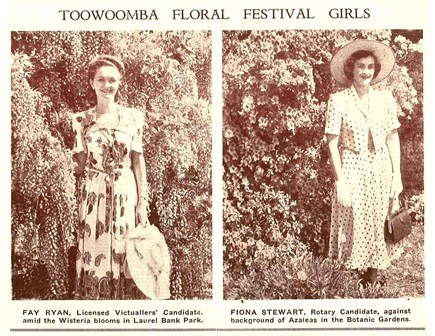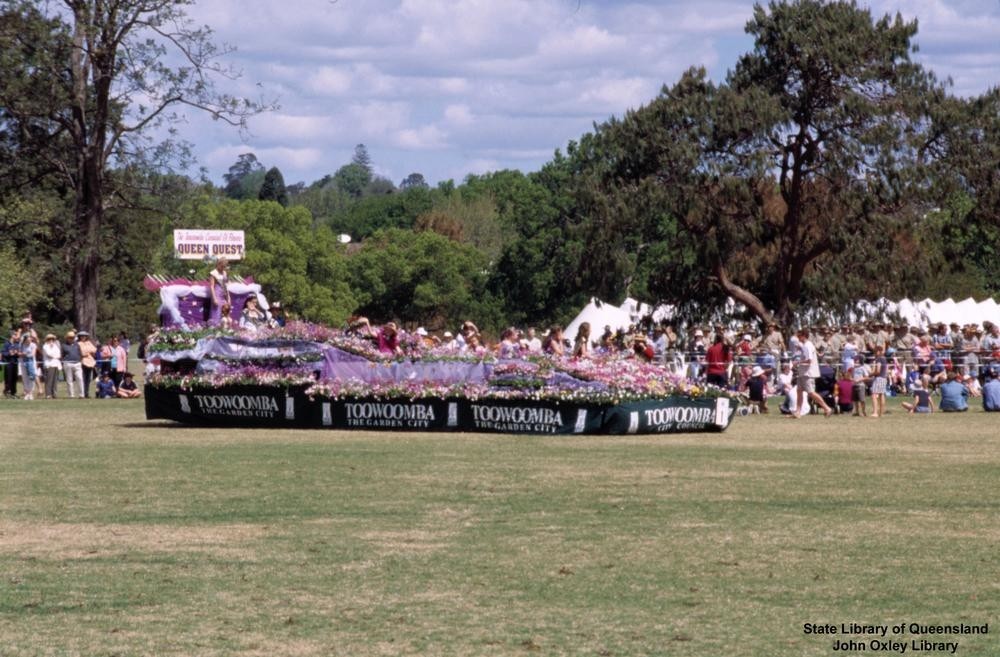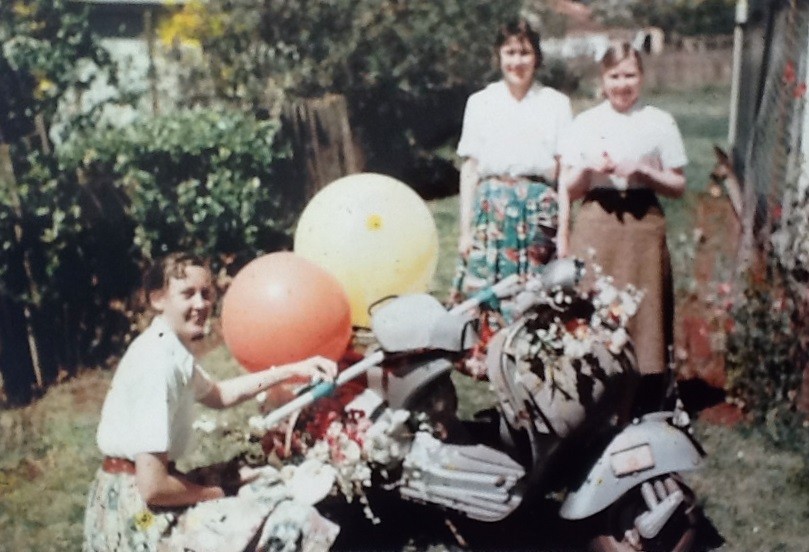In this episode of “The Centaur Fund Series”, Madonna Grehan, guest blogger and John Oxley Library Fellow for 2015, sheds light on Toowoomba’s first Queen of the Carnival of Flowers.
On Saturday evening 28 October 1950, a reported crowd of 40,000 people assembled at the corner of Ruthven and Margaret Streets, eagerly anticipating the crowning of Toowoomba’s inaugural Queen of the Carnival of Flowers, Miss Fay Ryan. It was an event embedded with pageantry.

Toowoomba Floral Festival girls from Centaur Floral Festival - Mardi Gras souvenir program
At 8.30pm a trumpet fanfare announced the Queen’s arrival. A page preceded her, bearing the all-important crown on a pillow. Resplendent in a white coronation gown, the winner of the competition gracefully ascended the dais and took the throne. Senator Annabelle Rankin MP declared Toowoomba’s thanks to Miss Ryan for her philanthropic efforts and crowned the Carnival Queen. With formalities concluded, this regal party made a short walk to meet and greet some of the crowd. The whole show went off without a hitch, surprising and delighting onlookers.
The spectacle’s success, in part, was thanks to detailed instructions on how to crown a queen, supplied by Joe Cranitch, Organising Secretary of the Centaur Memorial Fund Appeal in Brisbane. Going by newspaper reports of the Toowoomba event, Cranitch’s recommendations were followed to the letter.

Joe Cranitch, 1950, from Cranitch family collection
A Postal Official on extended leave from his permanent position, Cranitch had run the Centaur Fund’s highly successful Queen of the Nurses Quest in 1948. He had also been involved with organising the Miss Australia Quest in Queensland, raising money for the Returned Sailor’s Soldier’s & Airmen’s Imperial League of Australia.
Cranitch mapped out his imaginary plan for the Toowoomba Queen’s crowning on 11 October 1950, following an approach from Max S Herring, Manager of Queensland Trustees Ltd. Cranitch pointed out that although he was unfamiliar with the detail of the Toowoomba competition, the crowning of the queen was the highlight of events, and should be a dignified affair.
He described the lay-out of a stage for twenty people including dignitaries and the furniture necessary to seat them. As if rehearsing the event himself, he described the Queen’s arrival, recommending who should sit where, on the dais. He imagined the crowning in detail and the departure of the Queen with her attendants, whisked away from the enthusiastic street party to a waiting car.
For the benefit of the Toowoomba Committee, Cranitch posted a sample “scroll” that the Centaur Fund used as a ‘thank you’ message to its supporters. The Centaur Memorial Fund’s scroll was created by Bert Murphy, a draftsman employed by the Post Master General’s Department and son of the artist “Ned” Ashton Murphy. According to Cranitch’s description, Bert Murphy’s design bore several images: the 2/3 Australian Hospital Ship Centaur in the centre and in the four corners, a lamp representing the profession of nursing, Centaur House at 337 Queen Street in Brisbane, and two nursing badges. Cranitch recommended that Toowoomba fashion its own version of the scroll for Senator Rankin to use when proclaiming the Queen’s coronation.
The 1950 Carnival of Flowers was a roaring success, attracting throngs of visitors to the Darling Downs and securing Toowoomba’s profile as a “Garden City”. Combined, the four entrants in the inaugural Queen competition raised almost £1700 for Legacy and Toowoomba’s Youth Clubs. In December 1950, a public meeting confirmed that the event would be held annually.

Decorated float in the Carnival of Flowers parade in Toowoomba, 2002, John Oxley Library, State Library of Queensland Image number: twb00005

Photo of a scooter decorated for the Carnival Parade sent to us by Nurse Diana Patton, née Lyne
Footage of the crowning of the floral queen from the 1953 Carnival of Flowers can be viewed at the National Film and Sound Archive website.
Dr Madonna Grehan was the recipient of the 2015 John Oxley Library Fellowship. Her research articles on the Centaur Memorial Fund can be found here:
- ATNA Nurses’ Rest Home, 17-19 Mallon St, Bowen Hills
- Avenging the Nurses: Government’s response to the sinking of 2/3 Australian Hospital Ship Centaur
- Centaur Day, 14 May, and Red Roses for Remembrance
- Queen of the Nurses Quest
- Highlighting Queensland’s links to the Centaur Memorial Fund for Nurses
- How to crown a Queen
- Brisbane’s first street markets – The Spring Hill Fair
- The Diggers’ Friend: Sadie Charlotte Macdonald 1875-1970 (with Marg Doherty)
- Two men and a presentation cricket bat
- Len Shillam’s 2/3 AHS Centaur Memorial, 1957
- At the Brisbane Ekka, 1950-1977 – the Centaur Memorial Fund’s money spinner
- Flotsam from the 2/3 Australian Hospital Ship Centaur
- Fiesta Gardens 1948 – a touch of Hollywood at Slacks Creek (with Dr Hilda Maclean)
- Centaur House Memorial Hostel, Magnetic Island
- Centaur House, Mt Gravatt, 1949: Almost the first raffle of real estate in Queensland
- Centaur House, Queen St, Brisbane: A Memorial Edifice to Queensland’s Nurses in two World Wars
- A Centaur memorial event at State Library of Queensland, Monday 14 May 2018
- Centaur Memorial Fund For Nurses Records - Digitised @SLQ
- Centaur Day Commemorations 14 May
- Imagining Centaur
Comments
Your email address will not be published.
We welcome relevant, respectful comments.